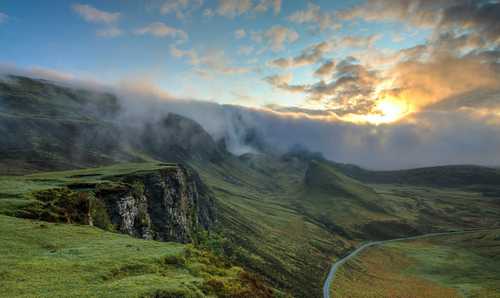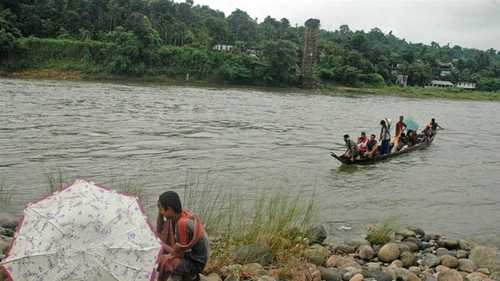News
NE temperature increased by 0.08 degree in past decade

Agartala: Northeast has recorded an increase in temperature by 0.08 degree Celsius in last decade along with static dispersion of seasonal weather phenomena in the region, Regional Director ICAR, Northeast, Dr S V Ngachan on Tuesday said.
Talking to UNI here, DR Ngachan said that Barapani in Meghalaya alone had recorded a rise in temperature by two degrees Celsius in last decade and rainfall in world famous Cherrapunji (highest rainfall area of India) has reduced substantially over the year changing the complete weather cycle of the region.
He also said the climate change has affected the northeast, one of the hotspots of bio-diversity, weather cycle, annual rainfall pattern and seasonal variation over past few years, which ultimately influenced the longer summer and shorter winter phenomenon.
Dr Ngachan underlined that the warm weather had now become good for agricultural production and several sub-tropical agricultural crops was now cultivated in northeastern states. Referring to the potable water scarcity in Tripura, Joint Director and noted agriculture scientist of ICAR Tripura Dr M Dutta said the state is blessed with plenty of rainfall, but because of lack of storage facilties water flows down to Bangladesh and as a result, Tripura face water crisis pre and post monsoon days. Not only the potable water sources, because of the rise of all 14 river beds the water storage capacity had reduced substaintially and that also affected the irrigation system in agricultural sector,” Dr Dutta said, adding that only 22 per cent of the area of Tripura was under irrigation. (UNI)
Climate change here and now

Climate change is no longer just about rising temperatures but also about the unpredictability of weather conditions. We are seeing climate change right here, right now. The entire country has been having unseasonal rains. This is the planting season. Normally we don’t have the monsoons until early or mid June. But this is April and the rains have been with us every single day for nearly half a month. And instead of light spring showers we are having torrents with the possibility of seeds being washed away with the torrential rain waters. Strawberry- growing is now a good business venture in Meghalaya but this year the rains have played spoilsport and farmers fear that they may not even get their investments back. Without a viable crop insurance mechanism in place, the plight of farmers will only exacerbate. Indeed, farmers bear the worst brunt of climate change.
Changes in temperature, amount of carbon dioxide (CO2), and the frequency and intensity of extreme weather could have significant impacts on crop yields. While warmer temperatures may make many crops grow more quickly, they could also reduce yields. Crops tend to grow faster in warmer conditions. Extreme events, especially floods and droughts, can harm crops and reduce yields. Many weeds, pests and fungi thrive under warmer temperatures, wetter climates, and increased CO2 levels. Currently, farmers spend huge amounts on pesticides in this country in the hope of preventing their crops from pests and fungal diseases. But this is dangerous as deadly chemicals leach into our food chain.
Heat waves, which are projected to increase under climate change, could directly threaten livestock. A number of states have reported huge losses of animals during the heat wave in some states last year. Heat stress affects animals both directly and indirectly. Over time, heat stress can increase vulnerability to disease, reduce fertility, and reduce milk production. Climate change also increases the prevalence of parasites and diseases that affect livestock. The earlier onset of spring and monsoon and also warmer winters could allow some parasites and pathogens to survive more easily. The Meghalaya Government has invested much in Fisheries with the intent of making the state self sufficient in fish production by 2025. At present Meghalaya is dependent on denatured fish from Andhra Pradesh. But the unprecedented floods in Garo Hills in September last year led to a huge loss for farmers as all the fish ponds too were flooded. Dealing with unpredictable weather conditions will be the biggest challenge for Governments. Is the Government of Meghalaya prepared to deal with these erratic weather conditions? What, for instance are the emergent problems faced by farmers in Meghalaya apart from reduced productivity? The Government of Meghalaya had made tall claims about going organic. Has this sloganeering converted into a pragmatic action plan for reduced chemical fertilisers? What are the sources for organic manure in the State? We are yet to see an action plan on organic farming in Meghalaya.
Assam most vulnerable to climate change in Indian Himalayas

GUWAHATI: Among the 12 states in the Indian Himalayan Region (IHR), Assam is the most vulnerable to the changing climate, a Department of Science and Technology (DST) vulnerability assessment has found.
The study titled “Climate Vulnerability Assessment for the Indian Himalayan Region Using a Common Framework” was done by the Indian Institute of Technology-Guwahati and the Indian Institute of Technology-Mandi in collaboration with the Indian Institute of Science, Bengaluru, to help understand climate change vulnerabilities which could inform development of adaptation strategies and ecosystem management for the Himalayan region. The study was part of the Swiss-funded Indian Himalayas Climate Adaptation Programme (IHCAP).
The assessment is significant for India as a majority of its population is dependent on agriculture which requires water. The Himalayas are a source of many rivers which supply this water.
Bordering eight countries, the Himalayan mountain range is the tallest in the world. It covers an area of about 4.3 million square kilometres and nearly 1.5 billion people depend on it for water, food and energy. In India, the IHR spans across 12 states — Jammu and Kashmir, Himachal Pradesh, Uttarakhand, Sikkim, Arunachal Pradesh, Nagaland, Manipur, Mizoram, Tripura, Meghalaya, Assam and (hill districts of) West Bengal.
The vulnerability assessment was done on the basis of four major factors: socio-economic, demographic status and health, the sensitivity of agricultural production, forest-dependent livelihoods and access to information services and infrastructure.
The assessment stated that the “vulnerability index is found to be the highest for Assam and Mizoram, followed by Jammu and Kashmir, Manipur, Meghalaya and West Bengal, Nagaland, Himachal Pradesh and Tripura, Arunachal Pradesh and Uttarakhand”. Sikkim was found to be the least vulnerable among all these states.
The study explained that states with a low per capita income, low area under irrigation, low area under forests per 1,000 households and high area under open forests have received a high vulnerability score.
The report, however, emphasised that “vulnerability is a relative measure, which means that this assessment does not portray Sikkim, Uttarakhand or Arunachal Pradesh as having a low vulnerability in an absolute sense”.
India: ‘World’s wettest place’ suffers water shortage

Meghalaya state, India – For those recently debating climate change at the global summit in Paris, the coinciding deluge in India’s southern city of Chennai seemed a powerful illustration that the gathering urgently needed to succeed in its aims.
While flooding hit the south, an increasing lack of water in Cherrapunji, a northeastern town which was once the world’s wettest place, is causing growing concern among residents.
Both Indian examples point to the vicissitudes of climate change on our planet in a country where a rising population always creates huge pressures on the environment.
In 1861, Cherrapunji, known to locals as Sohra, created a world record with 22,987mm of rainfall in a year.
More than 150 years later, and experiencing an average annual rainfall of 11,430mm, it is still the second wettest place in the world.
Mawsynram, a village just six kilometres away and boasting an average annual rainfall of 11,887km, is now considered the dampest place on the globe.
However, the current rainfall in Cherrapunji, located in Meghalaya state, is just one third of what it was in the 1970s.
Residents rue rising Shillong temperature

A maximum temperature at around 28 degrees is too hot for hill station Shillong, the state capital of Meghalaya that stands at an altitude of 4,908 feet (1,496m) above sea level, and is known to be a destination providing “plenty of natural air conditioning”.
By Rining Lyngdoh
Shillong, April 11: A maximum temperature at around 28 degrees is too hot for hill station Shillong, the state capital of Meghalaya that stands at an altitude of 4,908 feet (1,496m) above sea level, and is known to be a destination providing “plenty of natural air conditioning”.
While people have lost lives in some parts of the country as the heat wave swept eastern and central India leading to temperatures rising over 40 degrees Celsius, Shillong is slowly feeling the same over the years. Thanks to climate change.
After experiencing cold weather coupled with thundersqualls and rain a week ago, the temperature has suddenly risen in Shillong in the past few days.
Last week, squalls and rain hit the city and other places damaging several houses and crops.
Shillong has always been considered a suitable destination for tourists during spring and summer. This is because one can feel the presence of natural air conditioning unlike in other parts of the country where people have to rely on an electric fan or air conditioner to cool themselves from the burning heat.
But Shillong’s weather is no longer like it was in the past, in view of climate change, which has led to global warming across the globe.
Shillong is just 10km from Shillong Peak, which is the highest point at 6,449 feet (1,966m) above sea level.
The city has never experienced temperatures over 30 degrees, except 43 years ago.
The kind of heat felt in the city today made many feel that the temperature might have touched 30 degrees Celsius. Students and elders alike used their umbrellas to shield themselves from the heat, while children opted for ice creams to cool themselves. The wind helped pedestrians cool down a bit.
An official in the Indian Meteorological Department here, told The Telegraph that the maximum temperature recorded in the city today was 28.1 degrees Celsius.
“Shillong has never experienced temperatures beyond 30 degrees Celsius, except in 1973. The highest temperature ever recorded in the city was in April 1973, at 30.2 degrees Celsius,” an official said.
The official said the second highest temperature was 29.7 degrees Celsius, recorded in June 1999 followed by 29.5 degrees Celsius in May 1979 and April 2014 and 28.7 degrees Celsius in April 2014.
Sources said in the last one week the temperature in Shillong has risen from 24.5 degrees Celsius on April 6 to 27.9 degrees Celsius on April 10.
The sources observed that the temperature of Shillong might increase further in the coming days if the city receives no rain.
